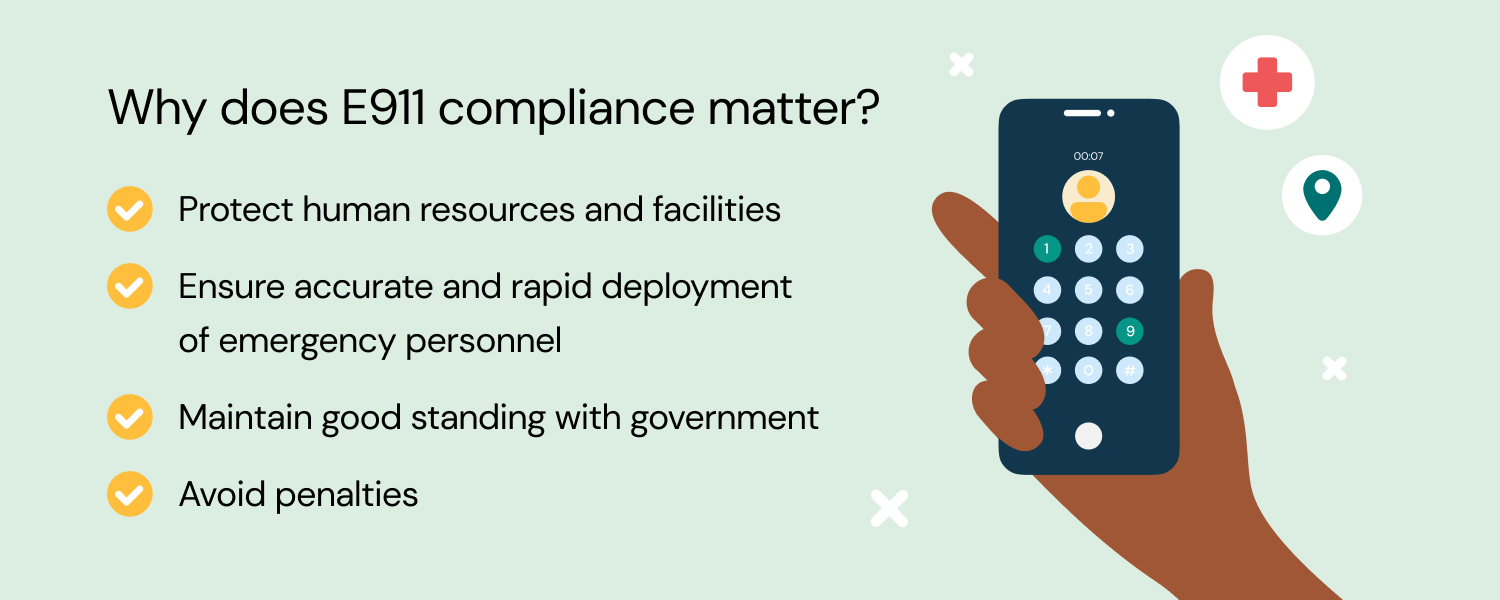When there’s an emergency, you dial 911. This seems like it should be a relatively simple step to help prevent an emergency from becoming a catastrophe. Unfortunately, it hasn’t always been this way in the past. That’s why Kari’s Law and RAY BAUM’s Act were passed, and why E911 is so important.
Kari’s Law was implemented as a result of a horrific tragedy involving a young mother of three because 911 services couldn’t be reached during the emergency.
Kari’s Law is a significant government regulation to be aware of because it impacts businesses relying on multi-line phone systems and the manufacturers and service providers (including providers of cloud-based unified communications service) offering them.
But what is Kari’s Law and the RAY BAUM’S Act, and how does E911 compliance tie into them? What implications does it have for businesses like yours? Let’s dive into detail about the regulations, how they affect your company, and what you can do to follow them.
What is Kari’s Law?
In 2013, the estranged husband of Kari Hunt Dunn killed her in a hotel room. Her daughter attempted to contact 911 multiple times but failed because the hotel’s phone system required guests to dial “9” before an outgoing call.
While the daughter did attempt to notify nearby hotel employees, they could not inform management due to a language barrier. Sadly, investigations later found that Kari’s death might have been avoided had contact with emergency services been successful.
Kari’s death moved her father to start a state and nationwide effort to pass new legislation preventing similar cases in the future. The result was Kari’s Law, which had unanimous, bipartisan support from the Senate and House of Representatives and became law on February 16, 2018.
The legislation stated organizations must configure their multi-line telephone systems (MLTS) so users can dial 911 directly without requiring prefixes, access codes, or other obstacles.
Kari’s Law also requires notification support for MLTS, which is mandatory for any system not requiring hardware or software development to support this feature and meet compliance requirements. Plus, it’s mandatory for new MLTS deployments to have notification of emergency calls delivered to a central location at the facility where the system is installed, or to another person or organization regardless of location.
The emergency call notification must include the following: details that a 911 call was made, the emergency response location provided to the public safety answering point (PSAP), and the callback number of the caller when technically feasible.
What is the RAY BAUM’S Act (Section 506)?
Under the RAY BAUM’S Act (Section 506), the Federal Communications Commission (FCC) adopted rules to ensure a “dispatchable location” is conveyed with 911 calls, regardless of the technological platform used. With this law in place, 911 call centers will receive the caller’s location automatically and can more quickly dispatch responders. “Dispatchable location” is considered “the street address of the calling party, and additional information such as room number, floor number or similar information necessary to adequately identify the location of the calling party”. These new FCC rules were published in the Federal Register on December 6, 2019, and required all fixed and non-fixed MLTS, interconnected voice over Internet protocol (VoIP), telephone relay services (TRS) and fixed telephony to be in compliance with the “dispatchable location” component of the regulation by January 6, 2021 for fixed MLTS, fixed interconnected VoIP, fixed telephony and fixed TRS, or January 6, 2022 for non-fixed MLTS, non-fixed VoIP, and non-fixed TRS.
How are Kari’s Law and the RAY BAUM’S Act related?
Both Kari’s Law and the RAY BAUM’S Act deal with E911 and MLTS. Kari’s Law focuses on ensuring individuals can reach emergency service by directly dialing 911 in business environments and requires notifying designated personnel (such as security or a receptionist). The RAY BAUM’S Act (Section 506) is concerned with the quality of information being provided to public safety agencies when the call is made. The combined legislation safeguards reliable, accurate, and quick access to emergency services to protect all of us when dialing 911. Further details are available on the Federal Register of the United States Government.
What is E911?
E911, or Enhanced 911, is the part of the emergency phone call system that automatically targets a location to the call. This can be a specific address or coordinates. Calls to 911 are routed to a PSAP. E911 identifies the location of the caller and routes the call to the appropriate local PSAP, providing it with location information to ensure emergency services can respond quickly. The FCC requires carriers and interconnected VoIP providers meet all industry 911 standards.

Why does E911 compliance matter?
It’s not easy to follow all the different local, state, and federal laws, but companies must still spend resources tracking changes in legislation and finding ways to stay compliant.
Protect your human resources and facilities
Your business needs to have a complete safety protocol for human resources and facilities. Complying with E911 regulations allows you to adequately plan for the safety of remote workers, satellite campuses, etc.
Ensure accurate and rapid deployment of emergency personnel
If your business doesn’t alert security teams and other key personnel when a 911 call has been made, or if you fail to provide a dispatchable location at the time of the call, it will most likely delay help and waste precious time, making it difficult for emergency personnel to help the caller. It can be the difference between life and death for the people in need.
Avoid penalties
If your business fails to comply with local regulations, the government may levy fines and other penalties, or even threaten suspension in extreme cases. You’ll also lose the trust of your customers and business partners if there is legal action against your company.
Maintain good standing
Organizations must interact with the government often. In Florida, for example, companies must file reports every year and register with the state to approve certain business activities. Keeping in good standing with the government enables you to obtain credit or open bank accounts for work purposes more easily.
What implications does E911 compliance have on businesses?
What do these developments mean for your company? As mentioned, compliance comes with its own legal and financial benefits. The way you fulfill the conditions of this law will determine how much it affects your organization and the safety of your users.
Companies relying on outdated legacy systems should think about upgrading their emergency contact systems. Not only is it required by law, but it can improve emergency response times. If an employee undergoes a severe medical episode, getting the paramedics on the premises as quickly as possible is vital. A lack of location information plagues many 911 calls.
As of February 16, 2020, businesses are required to ensure their communication systems are in line with Kari’s Law. Specifically, contacting 911 should be instant. The system must inform all staff, including the front desk and security office, of the emergency. Finally, the phone system should provide information on where the call started.
As for multi-line telephone systems, the law includes unified communication (UC) platforms as well. If your business uses VoIP, make sure your service provider understands and complies with the new law.
Non-fixed VoIP services (such FaceTime users on mobile devices) are not under this law, as the user may not have location services enabled.
How can you stay compliant?
Kari’s Law does not require challenging or even expensive compliance methods. Here are some options your organization should consider now:
-
Disable any prefix numbers (like dialing “9” before outgoing calls) in your office phone system.
-
Implement notifications for personnel either through email, SMS, or phone when an incident occurs.
-
Install additional software or equipment if necessary.
-
Your phone system must identify the exact building, floor, suite, or room from where a call originates. Emergency services need more than just an address to respond quickly.
-
Consider adopting NG911, an emerging technology streamlining 911 contacts by replacing outdated infrastructure.
-
Ensure emergency personnel can enter your building when they arrive by allowing them to access elevators, doors, and keycard areas.
-
Keep track of state and local jurisdictions, which may have more stringent laws in place as well. Enact additional policies, if necessary.
How Sinch helps you stay compliant
Sinch is committed to continually updating our 911 network so we can help our customers maintain the highest level of safety for their businesses. Our UCaaS platform is compliant with Kari’s Law and RAY BAUM’S Act, supporting direct dial 911 and emergency response locations. 933 address verification is also supported, which returns the associated emergency response location for the originating telephone number.
Remember, you are enabling not only good standing with the government, but also improved safety for your clients and a lower chance of disaster happening at your business.
If you need additional details for achieving compliance with this ruling, consult the FCC’s website regarding Kari’s Law and RAY BAUM'S Act for up-to-date information and to assure businesses meet the requirements in a cost-effective manner.
Learn more about the implications of Kari’s Law with Sinch
Impactful policies like Kari’s Law and RAY BAUM’S Act are beneficial in many ways. They serve as an important reminder innovation is still needed in communication technologies.
For additional questions about the Sinch unified communications platform and its E911 compliance, get in touch with us today.



